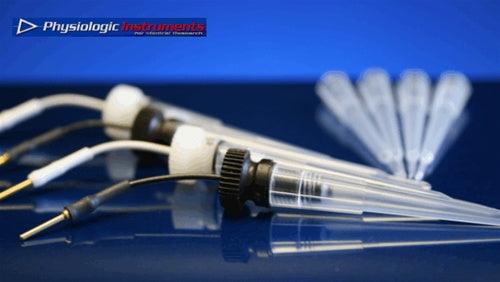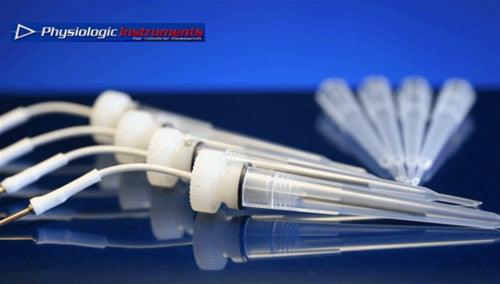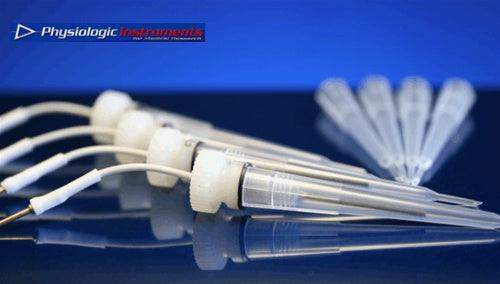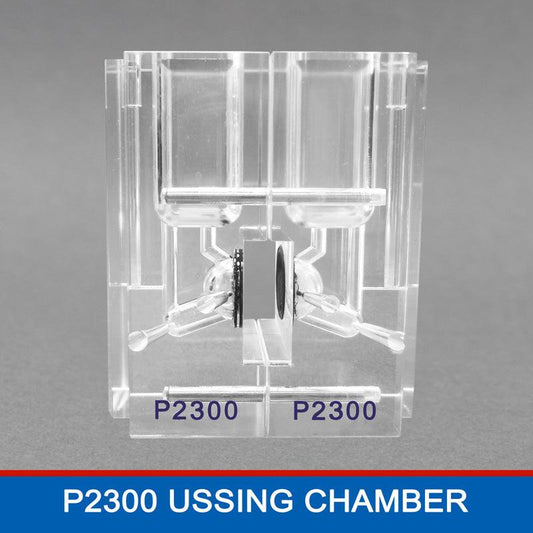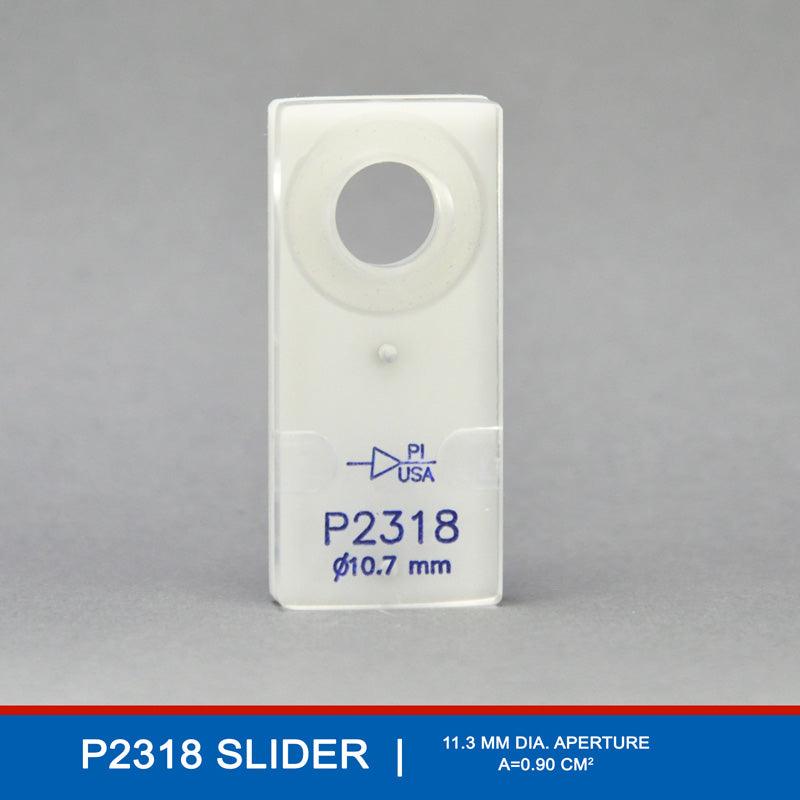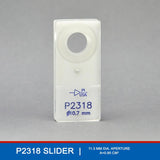P2318 EasyMount Ussing Chamber Slider
The P2318 EasyMount Ussing Chamber Slider is expertly designed for use with the P2300 Ussing Chamber, optimized for mounting delicate tissues like frog skin in physiological and transport studies. Its 10.7 mm diameter with a 0.9 cm² aperture provides a robust yet precise interface for measuring skin properties, with the slider tailored specifically to minimize edge damage, thus preserving tissue integrity. Used with the specialized washer (P2318-O), it allows secure adhesion of the tissue, ensuring that the skin remains flat and taut throughout the experiment. This combination of secure mounting, edge protection, and compatibility with the P2300 Ussing Chamber makes the P2318 an ideal choice for researchers requiring consistent, high-quality data on membrane transport and barrier function in amphibian skin.
⦿ To be used with P2300 EasyMount Ussing Chambers- Regular price
- $218.00
- Regular price
-
- Sale price
- $218.00
- Unit price
- per
EasyMount Slider Details

P2318 EasyMount Ussing Chamber Slider for Fog Skin Glued To Washer
APETURE SIZE: 10.7MM | Area = 0.9 cm2
The P2318 EasyMount Ussing Chamber Slider is a specialized 10.7 mm diameter tissue holder engineered for use with the EasyMount Ussing Chamber model P2300, specifically tailored to accommodate frog skin and other similar biological tissues. This slider incorporates a 0.9 cm² circular aperture, providing an optimal interface area for physiological and transport studies on amphibian skin. Designed for use with the specialized washer (part number P2318-O), the P2318 slider enables the secure adhesion of frog skin to the washer, ensuring stable positioning during experiments.
A key feature of the P2318 slider is its design, which minimizes edge damage to delicate tissue samples. This construction effectively reduces the risk of tearing or compression around the periphery of the mounted tissue, preserving tissue integrity and supporting consistent experimental results. By allowing frog skin to be securely attached to the washer and subsequently positioned in the chamber, this slider facilitates in-depth analysis of skin transport mechanisms, ion flux, and barrier properties. Its compatibility with the P2300 Ussing Chamber system and its protective design make the P2318 EasyMount Slider an essential tool for researchers conducting detailed studies on amphibian skin physiology and transport processes under controlled experimental conditions.
P2318 EasyMount Ussing Chamber Slider Instructions
To effectively use the P2318 EasyMount Ussing Chamber Slider with the P2300 Ussing Chamber system for studies involving frog skin or similar tissues, follow these detailed steps on preparing, mounting, and conducting the experiment.
1. Preparing the Frog Skin Sample
- Dissection and Rinsing: Carefully dissect the frog skin, ensuring it is free from underlying muscle or other tissue layers that could impact its barrier function. Rinse the skin gently in physiological solution (e.g., Ringer’s solution) to remove any residual mucus or debris.
- Trimming: Trim the tissue slightly larger than the 10.7 mm diameter aperture of the P2318 slider. This allows you to securely position the skin without risking shrinkage or displacement.
2. Mounting the Frog Skin on the Washer
- Choosing an Adhesive: Select a suitable adhesive that does not interfere with the physiological properties of the skin (typically, a medical-grade silicone adhesive or cyanoacrylate-based tissue glue). Ensure the adhesive is compatible with the P2318-O washer.
- Applying the Glue: Apply a thin, even layer of adhesive around the perimeter of the P2318-O washer, taking care to avoid the central area of the washer’s aperture to prevent interference with the exposed skin.
- Positioning the Skin: Gently place the frog skin over the washer, ensuring it fully covers the aperture. Press the edges of the skin onto the adhesive-coated area to secure it, ensuring the skin is flat and free from wrinkles or air pockets.
- Drying Time: Allow sufficient drying time for the adhesive, depending on its type, to ensure the skin is firmly attached. A few minutes are usually sufficient for most adhesives, but verify that the tissue is stable before continuing.
3. Assembling the P2318 Slider with the Mounted Skin
- Inserting the Washer: Once the skin is securely glued, carefully place the washer with the mounted skin into the P2318 EasyMount Ussing Chamber Slider. The design of the slider is optimized to minimize edge damage, supporting delicate tissues while reducing the risk of tearing or distortion around the aperture.
- Confirming Stability: Check that the washer is firmly seated in the slider and that the tissue is properly aligned over the 0.9 cm² aperture. This setup ensures uniform exposure for accurate measurement.
4. Mounting the Slider in the P2300 Ussing Chamber
- Preparing the Chamber: Fill the P2300 Ussing Chamber compartments with physiological solutions appropriate for frog skin, typically using a Ringer’s solution on each side to simulate in vivo conditions. Pre-warm the solution if necessary to match physiological temperatures.
- Positioning the Slider: Insert the P2318 Ussing chamber slider with the mounted skin into the Ussing chamber, ensuring a tight seal around the edges to prevent any solution leakage. Each side of the skin should face a separate chamber compartment, allowing for distinct solutions or treatments to be applied to either side.
- Setting Up Electrodes and Sensors: Place voltage and current electrodes in each chamber compartment according to the P2300 Ussing Chamber’s specifications, allowing for measurements of electrical potential and ion transport across the skin.
5. Conducting the Experiment
- Baseline Measurements: Record baseline parameters such as transepithelial resistance (TER) and short-circuit current (Isc) to assess the initial condition and viability of the skin.
- Experimental Treatments: Introduce experimental agents, such as ion channels or transport inhibitors, to one side of the chamber as needed to study their effects on skin transport properties.
- Data Collection: Continuously monitor and record changes in TER, Isc, or other relevant parameters to analyze transport mechanisms, permeability, or other physiological responses of the frog skin.
6. Completing the Experiment and Cleaning
- Data Analysis: After completing data collection, save and analyze the data to evaluate the physiological or pharmacological effects observed during the experiment.
- Disassembly and Cleaning: Carefully remove the P2318 slider from the Ussing chamber, detach the washer, and dispose of or clean the tissue as appropriate. Rinse the P2318 slider and other chamber components with distilled water, followed by a compatible cleaning solution, to prepare for future use.
By following these steps, the P2318 EasyMount Ussing Chamber Slider and P2300 Ussing Chamber system enable precise and reproducible studies on the transport properties and physiological responses of frog skin. The slider’s design supports delicate tissue samples while reducing potential edge damage, ensuring consistent and reliable experimental conditions. If you need any assistance, please contact us.


